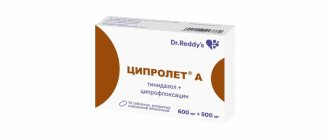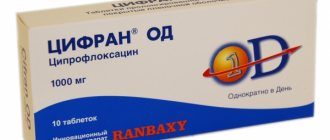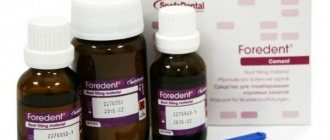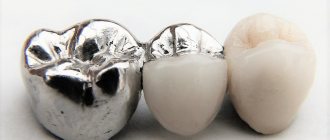Throughout his life, a person often encounters the negative effects of microbes on the body. Bacterial pathogens can settle on the skin, in the gastrointestinal tract, in the genitourinary organs and even on the conjunctiva of the eye. In such a situation, only a strong antibacterial agent will help cope with the infection. Most often, treatment begins with medications based on ciprofloxacin, so doctors often prescribe the antibiotic Tsiprolet to patients. Next we will talk about the beneficial properties of this medication.
Release form
Tsiprolet is produced by many pharmaceutical companies, as it is one of the most popular antibacterial agents. It is produced in the following dosage forms:
- infusion solution - in polyethylene bottles of 100 ml, where the content of ciprofloxacin does not exceed 2 mg per ml;
- tablets - each containing 250 mg or 500 mg of the main active ingredient, they are packaged in blisters of 10 pieces;
- eye drops - sold in bottles with a dropper of 5-10 ml, which contain 3 mg of ciprofloxacin per 1 ml of solution.
According to the instructions for use of Tsiprolet 500, these tablets contain the maximum dose of the active substance. They are used to treat severe bacterial lesions in advanced infections.
Comparison of ease of use of Tsiprolet A and Tsiprolet
This includes dose selection taking into account various conditions and frequency of doses. At the same time, it is important not to forget about the release form of the drug; it is also important to take it into account when making an assessment.
The ease of use of Tsiprolet A is approximately the same as Tsiprolet. However, they are not convenient enough to use.
The drug ratings were compiled by experienced pharmacists who studied international research. The report is generated automatically.
Last update date: 2020-12-04 13:48:25
Mechanism of action of the drug
Tsiprolet belongs to the group of fluoroquinolones and is an antibacterial drug with a wide range of effects. Its main active ingredient is ciprofloxacin. This chemical compound has the ability to penetrate the DNA structure of the cells that cause the infection, thereby disrupting the vital functions of bacteria, their ability to subsequently reproduce and develop. The result of this influence is the death of harmful microorganisms.
Tsiprolet tablets have a complex effect, effectively destroying microbes that are both at the reproduction stage and in the resting phase. The spectrum of negative effects of this medicine extends to almost all types of gram-positive and gram-negative bacteria, most of the anaerobic pathogens. The instructions for use of Tsiprolet state that its main active component actively eliminates bacterial microflora that are resistant to other antibiotics, for example, the nitrofuran or sulfonamide series. Resistance of microbes to this medicine appears only after a long period of time.
Indications
Ciprofan tablets - what do they help with? This antibiotic is used for the treatment of complicated or uncomplicated bacterial infections that are caused by strains of microorganisms sensitive to ciprofloxacin. The remedy is indicated for the following diseases:
- urinary tract infections;
- bacterial lesions of the gastrointestinal tract;
- sepsis;
- pathologies of ENT organs, especially in case of infection with staphylococcal microflora and gram-negative bacteria, including the Pseudomonas type;
- peritonitis;
- infectious lesions of the respiratory system (for example, pneumonia), if they are caused by Enterobacter, Staphylococcus, Klebsiella, Haemophilus influenzae, Legionella or microbes of the Branhamella, Pseudomonas species;
- inflammatory infectious diseases of the genital organs in men and women (prostatitis, adnexitis);
- infections of the musculoskeletal system and skin;
- some sexually transmitted diseases (gonorrhea);
- bacterial lesions of the eyelid and conjunctiva of the eyes;
- therapy and prevention of infections in patients with low immunity (for example, with neutropenia or after treatment with immunosuppressive drugs).
Comparison of addiction between Tsiprolet A and Tsiprolet
Like safety, addiction also involves many factors that must be considered when evaluating a drug.
So, the totality of the values of such parameters as “syndrome o” in Tsiprolet A is quite similar to the similar values in Tsiprolet. Withdrawal syndrome is a pathological condition that occurs after the cessation of intake of addictive or dependent substances into the body. And resistance is understood as initial immunity to a drug; in this it differs from addiction, when immunity to a drug develops over a certain period of time. The presence of resistance can only be stated if an attempt has been made to increase the dose of the drug to the maximum possible. At the same time, in Tsiprolet A the values of “syndrome o” are quite small, however, the same as in Tsiprolet.
Dosage and methods of application
The antibiotic Tsiprolet is prescribed by a doctor after examining the patient. The dose of the drug is selected based on the type of infection, the severity of the disease and the patient’s condition. The dosage regimen is also influenced by the functional ability of the urinary organs and the person’s body weight (when used in adolescence and childhood).
For the most severe cases of infection and when it is impossible to take the medication in tablet form, Tsiprolet is prescribed in the form of infusion solutions. Then the intravenous infusions of the drug are gradually stopped, and the patient switches to internal administration of the medication. The tablets do not need to be chewed; they simply need to be swallowed whole and washed down with a small amount of water. Take Tsiprolet, regardless of food intake, 500-750 mg twice a day.
The duration of therapy depends on the severity of the pathology and can vary from 3 to 21 days. Usually the doctor prescribes the use of this antibiotic for a period of 7 to 14 days.
Comparison of safety of Tsiprolet A and Tsiprolet
The safety of a drug includes many factors.
At the same time, in Tsiprolet A it is quite similar to Tsiprolet. It is important where the drug is metabolized: drugs are excreted from the body either unchanged or in the form of products of their biochemical transformations. Metabolism occurs spontaneously, but most often involves major organs such as the liver, kidneys, lungs, skin, brain and others. When assessing the metabolism of Tsiprolet A, as well as Tsiprolet, we look at which organ is the metabolizing organ and how critical the effect on it is.
The risk-benefit ratio is when the prescription of a drug is undesirable, but justified under certain conditions and circumstances, with the obligatory observance of caution in use. At the same time, Tsiprolet A does not have any risks when used, just like Tsiprolet.
Also, when calculating safety, it is taken into account whether only allergic reactions occur or possible dysfunction of the main organs. In other matters, as well as the reversibility of the consequences of using Tsiprolet A and Tsiprolet.
Adverse reactions and contraindications for use
Tsiprolet very rarely causes allergic reactions. After treatment with this medication, the following side effects most often develop: dyspeptic disorders, nausea and vomiting, skin itching and rash, shortness of breath.
The use of this medicine is contraindicated in the following cases:
- during pregnancy;
- if you are allergic to ciprofloxacin and quinolone drugs;
- in adolescence and childhood;
- during lactation.
Tsiprolet is prescribed with caution to elderly patients. The medication is used only in special cases for people suffering from epilepsy, vascular pathologies, and organic diseases of the brain. Such patients are more likely to experience side effects due to taking the drug, so this antibiotic is indicated for them only in life-threatening situations. In case of allergic reactions and other complaints (for example, joint pain, myalgia), use of the medicine should be discontinued.
Tsiprolet film-coated tablets 500 mg 10 pcs. in Naro-Fominsk
Drugs that cause prolongation of the OT interval
Caution should be exercised when simultaneous use of ciprofloxacin as well as other fluoroquinolones in patients receiving drugs that cause prolongation of the QT interval (for example, class IA and III antiarrhythmic drugs, tricyclic antidepressants, macrolides, antipsychotics).
Chelation formation
Simultaneous intake of tablet forms of ciprofloxacin and cation-containing preparations of mineral supplements containing calcium, magnesium, aluminum, iron sucralfate, antacids, polymeric phosphate compounds (sevelamer lanthanum carbonate) and drugs with a large buffer capacity (such as didanosine tablets) containing magnesium, aluminum or calcium reduces the absorption of ciprofloxacin. In such cases, ciprofloxacin should be taken either 1-2 hours before or 4 hours after taking these drugs.
This restriction does not apply to drugs belonging to the class of H2-histamine receptor blockers.
Intake of food and dairy products
The simultaneous use of ciprofloxacin and dairy products or drinks fortified with minerals (milk, yogurt, calcium-fortified orange juice) should be avoided since the absorption of ciprofloxacin may be reduced. However, calcium contained in other foods does not significantly affect the absorption of ciprofloxacin.
Omeprazole
With the combined use of ciprofloxacin and omeprazole, a slight decrease in plasma Cmax and a decrease in the area under the concentration-time pharmacokinetic curve (AUC) may be observed.
Theophylline
The simultaneous use of ciprofloxacin and drugs containing theophylline may cause an undesirable increase in the concentration of theophylline in the blood plasma and, accordingly, the occurrence of theophylline-induced adverse events; in very rare cases, these adverse events can be life-threatening for the patient. If the simultaneous use of these two drugs is necessary, it is recommended to constantly monitor the concentration of theophylline in the blood plasma and, if necessary, reduce the dose of theophylline.
Other xanthine derivatives
The simultaneous use of ciprofloxacin and caffeine or pentoxifylline (oxpentifylline) may lead to an increase in the concentration of xanthine derivatives in the blood serum.
Nonsteroidal anti-inflammatory drugs
The combination of very high doses of quinolones and some non-steroidal anti-inflammatory drugs (excluding acetylsalicylic acid) can provoke seizures.
Cyclosporine
With the simultaneous use of ciprofloxacin and drugs containing cyclosporine,
short-term transient increase in plasma creatinine concentration. In such cases, it is necessary to determine the concentration of creatinine in the blood twice a week.
Oral hypoglycemic agents
With the simultaneous use of ciprofloxacin and oral hypoglycemic agents, mainly sulfonylureas (for example, glibenclamide glimepiride), the development of hypoglycemia may be due to an increase in the effect of oral hypoglycemic agents.
Probenecid
Probenecid slows down the rate of excretion of ciprofloxacin by the kidneys. The simultaneous use of ciprofloxacin and drugs containing probenecid leads to an increase in the concentration of ciprofloxacin in the blood serum.
Phenytoin
With the simultaneous use of ciprofloxacin and phenytoin, a change (increase or decrease) in the content of phenytoin in the blood plasma was observed. It is recommended to monitor phenytoin therapy in patients taking both drugs, including determining the level of phenytoin in the blood plasma.
Methotrexate
With the simultaneous use of methotrexate and ciprofloxacin, the renal tubular transport of methotrexate may slow down, which may be accompanied by an increase in the concentration of methotrexate in the blood plasma. This may increase the likelihood of developing side effects of methotrexate. In this regard, patients receiving concomitant therapy with methotrexate and ciprofloxacin should be closely monitored.
Tizanidine
As a result of a clinical study involving healthy volunteers, the simultaneous use of ciprofloxacin and drugs containing tizanidine revealed an increase in the concentration of tizanidine in the blood plasma: an increase in Cmax by 7 times (from 4 to 21 times) an increase in AUC by 10 times (from 6 to 24 times). Hypotensive and sedative side effects are associated with increased serum concentrations of tizanidine. Therefore, the simultaneous use of ciprofloxacin and drugs containing tizanidine is contraindicated.
Duloxetine
During clinical studies, it was shown that the simultaneous use of duloxetine and potent inhibitors of the CYP450 1A2 isoenzyme (such as fluvoxamine) may lead to an increase in the AUC and Cmax of duloxetine. Despite the lack of clinical data on possible interactions with ciprofloxacin, the likelihood of such an interaction can be anticipated when ciprofloxacin and duloxetine are used simultaneously.
Ropinirole
The simultaneous use of ropinirole and ciprofloxacin, a moderate inhibitor of the CYP450 1A2 isoenzyme, leads to an increase in the Cmax and AUC of ropinirole by 60 and 84%, respectively. Monitor for adverse effects of ropinirole during coadministration with ciprofloxacin and for a short time after completion of combination therapy.
Lidocaine
In a study on healthy volunteers, it was found that the simultaneous use of drugs containing lidocaine and ciprofloxacin, a moderate inhibitor of the CYP450 1A2 isoenzyme, leads to a decrease in the clearance of lidocaine by 22% when administered intravenously. Despite the good tolerability of lidocaine, when used simultaneously with ciprofloxacin, side effects may increase due to interaction.
Clozapine
With the simultaneous use of clozapine and ciprofloxacin at a dose of 250 mg for 7 days, an increase in serum concentrations of clozapine and N-desmethylclozapine was observed by 29% and 31%, respectively. The patient's condition should be monitored and, if necessary, the dosage regimen of clozann should be adjusted during its combined use with ciprofloxacin and for a short time after completion of combination therapy.
Sildenafil
With simultaneous use of ciprofloxacin at a dose of 500 mg and sildenafil at a dose of 50 mg in healthy volunteers, a 2-fold increase in Cmax and AUC of sildenafil was observed. In this regard, the use of this combination is possible only after assessing the benefit/risk ratio.
Vitamin K antagonists
The combined use of ciprofloxacin and vitamin K antagonists (for example, warfarin acenocoumarol fenprocoumon fluindone) may lead to an increase in their anticoagulant effect. The magnitude of this effect may vary depending on concomitant infections, age and general condition of the patient, so it is difficult to assess the effect of ciprofloxacin on increasing the international normalized ratio (INR). The INR should be monitored quite frequently during co-administration of ciprofloxacin and vitamin K antagonists and for a short time after completion of combination therapy.
Special information
Tsiprolet is not effective against streptococci, so it is not prescribed for the treatment of pathologies caused by bacteria of this group. In case of severe infection by anaerobes and staphylococcal microflora, it is better to take the medication in combination with other antibiotics, which will help enhance the therapeutic effect of ciprofloxacin.
The instructions for Tsiprolet tablets indicate that this drug can have an effect on the patient’s body, changing the ability to concentrate. Therefore, it should not be used by transport drivers and persons servicing complex mechanisms and machines. It is unacceptable to use the medication in combination with alcohol. Tsiprolet is available only with a doctor's prescription.
Comparison of the effectiveness of Tsiprolet A and Tsiprolet
Tsiprolet A is more effective than Tsiprolet - this means that the ability of the medicinal substance to provide the maximum possible effect is different.
For example, if the therapeutic effect of Tsiprolet A is more pronounced, then it is impossible to achieve this effect with Tsiprolet even in large doses.
Also, the speed of therapy is an indicator of the speed of the therapeutic action; Tsiprolet A and Tsiprolet are also different, as is bioavailability - the amount of a medicinal substance reaching the place of its action in the body. The higher the bioavailability, the less it will be lost during absorption and use by the body.









